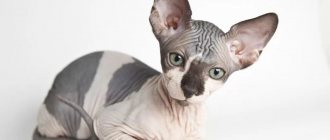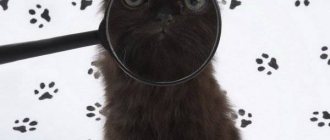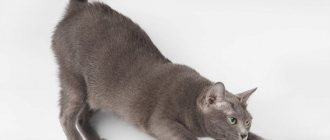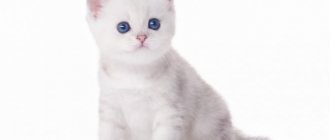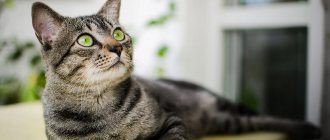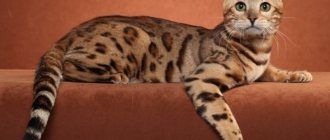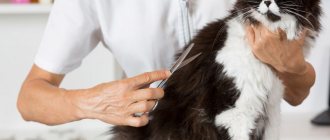History of the Exotic Shorthair cat breed
Exotic Shorthair cat
The appearance of the Exotic Shorthair breed dates back to the 50s of the last century. Frankly speaking, the first kittens appeared completely by accident. Wanting to get new coat colors and eye colors, American Shorthair breeders crossed their pets with Persian cats. Another goal of these attempts was to make the physique of “American women” more dense. The task was not solved. The offspring, to the surprise and disappointment of the breeders, turned out to be very “Persian” - all the animals were born with characteristic “doll” faces. And in other respects, the kids were more like their parents “from the East.” Only the fur became noticeably shorter and acquired a denser, plush structure. As a result of crossing, it was not possible to improve the American Shorthair cat breed, but completely new kittens with an outlandish appearance were born.
Already in 1966, Jane Martink introduced a new breed, which was given the name “Exotic Shorthair”. The accidentally bred cats took a long time to achieve recognition. Ambitious people were critical of “exotics”, believing that they encroached on the purity of this breed. It got to the point that they refused to mate their elite pets with exotic shorthairs, and they did this consciously and in an organized manner. Fortunately, there were far-sighted owners of the “Persians” who saw the prospects and took part in the selection. Among them, special mention should be made of Doris Walkinstick and Caroline Bussey, whose merits in the formation of a new breed can hardly be overestimated.
Representatives of the Russian Blue breed and Burmese cats were also used in breeding work. The experiments were stopped only when the shorthair gene was firmly established. Since then, matings of exotics have been possible only with Persians.
In 1990, felinologists came to an agreement that the breed standard completely duplicates all the requirements for the Persian cat, with the exception of the length and quality of the coat. Based on these agreements, all changes that are made to the Persian breed standard automatically become relevant for the exotic shorthair cat.
Difficulties of care
Those wishing to purchase a plush cat should know that a thick undercoat can cause some difficulties in care.
During shedding (and for many domestic cats it lasts all year round, because their biorhythms are disrupted), fur flies all over the apartment. At first glance, it seems that if an animal is short-haired, then it has less hair. This is wrong. There may be even more in quantity, because... The undercoat is thick, but collecting it from the floor and objects can be very problematic - no matter how much you collect, it is still everywhere. However, it is worth noting that not all shorthaired cats shed. Among the listed breeds there are no non-shedding ones, but there are individual representatives that are distinguished by this quality.
For those who shed, there are several recommendations. Firstly, such cats need to be brushed regularly during shedding. Ordinary scallops and even furminators are not suitable for this. The first ones do not give the desired result, practically without combing the undercoat. The latter can damage even the living undercoat, thereby depriving the cat of its beauty. A special glove is best suited for plush cats. Secondly, during shedding, such cats can be bathed, which helps to wash out the lost hair.
Is it worth buying such a kitten? If short hair and ease of care are the only reason you want to settle on a kitten belonging to one of the listed breeds, you should refuse the choice. There will be difficulties in care! Otherwise, caring for a plush cat is the same as caring for any other cat.
If you want such a cat because you are crazy about its beauty and are ready to put up with some difficulties for its sake, welcome to the website of Scottish and British cats “Murkotiki”, where you will learn a lot of information about these breeds.
Exotic appearance
Exotic kitten
The ideal exotic shorthair cat looks like a well-balanced animal with strong, even somewhat heavy bones. The coat gives the outline softness and roundness, the expression of the muzzle conveys complacency and calmness of character.
Head
Round in shape, quite massive. The skull is very wide with a round bone structure. The chin is well developed and round in shape. The jaws are strong and wide, the cheeks are full.
Eyes
The eyes of an exotic cat are located far from each other at the same level. The shape is large and round.
Ears
Small size, round shape. Set wide and low on the head, slightly tilted forward. Not very open at the base.
Nose
Wide, short and upturned. “Stop” is located clearly between the eyes.
Exotic cat face
Body
The body of exotics is medium or closer to large in size. Squat, with well-developed muscles, without signs of obesity. The chest is wide, the shoulders are massive.
Limbs
Exotic standing on his hind legs
Strong, short, massive. The front ones are straight, the rear ones are straight when viewed from behind.
Paws
Exotic paws are large and round. There are 5 toes on the front paws, 4 on the hind paws.
Tail
Proportional to body length, although it can rather be defined as short. No bends. The animal is held at a level below the back.
Wool
The exotic cat's coat is thick and plush, with a rich undercoat. Middle length. It feels very soft to the touch.
Disqualifying features
Visible weakness of the hind limbs, tail defects, number of toes that does not meet the standard. Strabismus, asymmetry of the muzzle or head. Visible deformities of the spine. White toes and non-blue eyes for color points.
American Curl
The American Curl is one of the most expensive cat breeds, first discovered in 1981 in California. These cute creatures are famous for their small protruding ears that resemble horns. Curls can be short-haired or long-haired, and their color comes in absolutely any color.
These cats have a graceful, medium-sized body and look quite well-fed. Females reach a weight of 3-5 kg, and males - 5-7 kg.
Representatives of American Curls are characterized by the following external signs:
- wedge-shaped head, wide ears turned at an angle from 90 to 180 degrees, large hazel-shaped eyes;
- rectangular body with a strong, straight chest;
- straight-set paws, strong neck, flexible and pointed tail.
American Curls do not have genetic diseases, despite the unusual shape of their ears. The curl gene of these animals does not have negative consequences for the health of the pet.
Find out all about the unusual American Curl cats.
Exotic photo
Character of an exotic cat
The character of the exotic shorthair is in amazing harmony with her charming appearance. Friendliness, calmness and complaisance make this animal a wonderful friend and companion. Pets are capable of sincere affection for their owner, but they show their feelings so delicately and subtly that they cannot be called intrusive. They will wait patiently until you finish your business, and only then will they remind you of their presence with a gentle, calm purr. Don't forget to give your friend enough time, because these cats can hardly tolerate loneliness.
With such a “cartoonish” and even somewhat clumsy appearance, exotics are quite active, inquisitive and agile. Moreover, showing natural curiosity, cats of this breed are able to lose their sense of danger. To avoid unpleasant or risky situations, try not to leave your pet alone for a long time. Both kittens and adult animals are playful. Many owners of exotic cats also note that they have well-expressed hunting instincts.
Adaptation of exotics to new conditions due to their livable nature does not present any particular difficulties. Your household, as well as pets already living in the house, will easily find a common language with this cute creature if they are in a positive mood.
Exotic shorthair cats have virtually no manifestations of aggression - in order to bring them out of a state of mental balance and serenity, you need to really want it. The manifestation of hostility, and even then in the form of attempts to avoid close contact, is possible only towards strangers.
Relationships with younger family members almost always go well. Exotics themselves love to play and will gladly take part in children's fun. All you have to do is control the degree of activity and safety of the game on the part of the “human cubs”.
From the point of view of a combination of character traits, temperament and intelligence, the Exotic Shorthair can rightfully be considered a cat ideal for home keeping.
White exotic nestled on the sofa
Habits and character of exotic cats
Although a cat of an exotic breed resembles a clumsy bear cub, it is actually a very active and playful creature. Teddy cats are very sociable, friendly and affectionate in nature.
global $ads_google; //data-ad-slot=”2475549904″ $ads_google = empty($ads_google) ? false : true; ?> if ($ads_google == false) {?> $ads_google = true; ?> } ?>
There is no need to worry whether the exotic will get along with dogs and other cats. Reviews from owners about his friendliness indicate that the affectionate cat will not offend other pets, and he himself serves as an adored creature.
Other good character traits include a cheerful disposition and curiosity. But you need to keep an eye on your exotic pet - a cat’s curiosity sometimes has no limits, and its sense of danger lets it down. If you don't pay attention, the animal can accidentally hurt itself by playing where it shouldn't. Potentially dangerous places should be kept under control.
This breed is ideal for families with children, with whom the moderately phlegmatic exotic purr will get along well. An affectionate friend will happily listen to the owner’s monologue, even if it is a many-hour description of all the sorrows that happened during the day. An exotic kitten will not refuse to play outdoor games. Growing up, he still won’t be able to resist playing with a piece of paper or a ball. Playful habits persist into old age.
Those who aren't too keen on loud-talking cats will be happy to know that these teddy bears are quiet. This is probably due to the peacefulness and calmness of exotics - it is quite difficult to anger such a cute animal.
The exotic cat is smart , so it can be trained and learned well. In order for the upbringing and learning process to bear worthy fruits, they should not be delayed. A kitten of this breed must be raised from the very beginning. All commands can be simplified, and at the same time, while pronouncing them, clap your hands softly.
Aggression is not acceptable during training, since the psyche of exotic cats is very susceptible. The cat’s trust cannot be undermined: if the kitten has no desire to follow commands at the moment, there is no need to force him.
Cats easily master the litter box and get used to the scratching post, which makes their existence in the house almost problem-free.
Education and training
Red bun
The Exotic Shorthair cat is very intelligent, perceptive and trainable. Practice has shown that exotics are able to remember simple commands and prohibiting words. To achieve lasting results, it makes sense to start training from the day you bring the kitten into the house. To make it easier to learn the simplest commands, you can accompany them with short exclamations or simply clap your hands.
The main rule of training is no aggression. The psyche of exotic cats is very sensitive, so you won’t find a better training method than love and patience. By forcing an exotic kitten to do anything through force, threats and intimidation, you will not only permanently lose his trust, but also cause serious harm to the baby's health.
Educational moments—training a kitten to use a litter box and a scratching post—usually pass without much difficulty. It is better to place the toilet in a quiet place where no one will distract your pet from his business. And so that your baby quickly understands the purpose of the scratching post, try spraying it with valerian tincture or a special product purchased at a pet store.
The character and behavior of the British
The British Shorthair has a gentle, calm disposition and is very attached to its home. She represses the expression of her emotions to such an extent that she may seem cold, but her true feelings are simply not shown clearly. In fact, her attachment to her owner or mistress is so deep that a British cat can become a person’s best friend and show this quality precisely at the moment when people most need support.
The British Shorthair is renowned for its excellent health
The plush cat, as he is now called by fans of his unusually pleasant-to-touch fur, has a far from plush character.
The British cat is independent, proud, cold and aristocratic, with a developed innate sense of self-esteem - the inherent qualities of this royal cat.
The English king among his subjects is as sweet, polite and tolerant of others when they are sweet, polite and loyal to him, as British cats are to their surroundings.
Care and maintenance
The exotic shorthair cat is an absolutely unpretentious creature. Professional grooming is not required, which is why representatives of the breed are sometimes called “Persians for the lazy.” But this does not mean that you don’t need to take care of your fur coat. The coat of exotics is very thick, voluminous, soft and well balanced with a soft undercoat. To keep the coat looking healthy and beautiful, you should comb it two to three times a week using a special high-quality metal comb. Like other felines, exotic shorthaired cats take care of their appearance by licking themselves, which is why experts recommend having a means to remove hairballs from the stomach in your veterinary medicine cabinet.
Combing an exotic's fur
Exotics need systematic bathing, at least once a month. The structural features of the animal's face require careful and attentive care - wipe it daily with a damp cloth, paying special attention to the condition of the eyes and tear ducts, as well as the cat's nose. Don't forget to trim your pet's nails twice a month using a safe nail clipper. It is unnecessary to remind you about the mandatory presence of a scratching post.
Provide your pet with a comfortable, safe place where he can rest peacefully. If this is a house, then purchase it in such a way that the animal has enough space to lie down, curled up in a ball or stretched out to its full length. Move your exotic cat closer to you - the pet does not tolerate loneliness well. Some representatives of the breed love to sit or lie for long periods of time on cool surfaces, such as tile floors. To prevent your animal from catching a cold, try to limit the time of these “cooling” procedures.
Om-Nom-nom
If you do not live on the ground floor, make sure there are protective nets on the windows. Exotic shorthairs are large animals, in some ways even obese, and a fall from a height can lead to the most severe consequences.
When deciding on nutrition, remember that adult animals are prone to obesity. To avoid such problems, teach your pet a proper, balanced diet from an early age. Immediately put a taboo on fatty foods and goodies from the common table. The diet should be based on protein products in organic combination with cereals, vegetables and vitamin complexes. The use of premium dry ready-made food from leading manufacturers is completely acceptable.
Important: if you use both dry food and natural products, never combine them. You can alternate, but you can mix – no!
Animal character
You can often hear the following characteristic about this breed: “a lazy cat for a lazy owner.” This emphasizes the special unobtrusiveness of its presence and the quiet disposition of the animal.
Having a balanced, calm character, the young cat is not at all averse to playing and running around in the company of children. But only according to my mood. Pets rarely give voice, only in cases where they want to ask for something.
These exotic animals are truly created as decoration or a toy; they are not annoying and their presence is unnoticeable and not burdensome. Despite the calm, patient character of a phlegmatic person, they quickly become attached to the owner (usually they choose a “leader”, like a pack of dogs) and are very fond of his company, attention and affection, and find loneliness difficult to bear.
Exotics are peaceful, quite curious, playful and intelligent animals, with a complete absence of signs of aggression. Cats quickly get used to their name and respond to it, but they have no particular talent for training. Instincts are highly developed: the mother cat takes care of the kittens with special love and care.
Health and disease of the exotic shorthair cat
Black Exotic
Exotic Shorthair is an artificially bred breed, which in essence is no different from its relatives - the Persians (except for the length and structure of the coat). It is absolutely logical that the genetic diseases in these two breeds are almost identical.
The most common diseases of the respiratory system and eyes occur in exotic animals. The reason is obvious - the unusual structure of the muzzle and the associated deformation of the nasolacrimal duct.
A genetic predisposition to kidney disease and cardiomyopathy is clearly visible. The latter disease very often causes the death of animals of this breed at an early age.
The oral cavity of the exotic can also be considered a risk zone, and a fairly high one at that. Without proper care of your gums and teeth, gingivitis, periodontal disease and other inflammatory diseases may occur. Sometimes cats have abnormally developed lower jaws, which can lead to problems eating.
The best prevention of the occurrence or complex course of these and other diseases is proper care and careful monitoring of your pet’s condition. Timely vaccination, deworming, preventive examinations at a veterinary clinic - all these simple measures will help you avoid unnecessary problems and maintain the health of your exotic shorthair cat for many years.
Catering
These wayward “Persians for the lazy” (exotics have this nickname) are not at all picky when it comes to food, and love to eat to their heart’s content.
A balanced diet should include the required amount of amino acids, protein, fats, trace elements and vitamins. Your pet can get this from both natural food and ready-made food (dry or wet).
The first option, according to most breeders and doctors, is better, although you will have to spend a lot of time on cooking. But the owner will be able to independently choose quality products and pamper the pet with a variety of dishes.
You cannot feed an animal from your table! Fried potatoes, cabbage soup, salads - all this is very harmful for a cat’s stomach and shortens your pet’s life by half.
Natural products
List of permitted products:
- Lean meat without veins and bones: beef, veal, rabbit, horse meat, chicken, turkey and lamb. A piece of meat is pre-frozen in the freezer (at least 2 days), and before feeding, it is scalded with boiling water (this helps to destroy pathogens and parasite eggs). Grinding meat into minced meat can only be done for a very old animal that has no teeth; for others, chewing is a necessary exercise and massage of the gums.
- By-products: lungs, chicken hearts, beef kidneys. They, like meat, are doused with boiling water or stewed.
- Fish cleared of bones, scales and entrails: trout, flounder, salmon, navaga, mackerel, cod, herring. It is better not to give river fish at all, since they are often infected with parasites. In addition, remember: if you give fish more than once a week, your pet will have kidney problems.
- Porridge: rice, millet, buckwheat, oatmeal, pearl barley. Porridge is cooked in water; milk can be added in small quantities (for taste). Babies up to 3 months are fed liquid semolina porridge, to which a drop of honey is added.
- Vegetables (carrots, pumpkin, zucchini, asparagus, broccoli, greens) are stewed or boiled, mixed with porridge and boiled chicken egg yolk, boiled quail eggs, and half a teaspoon of vegetable oil (sunflower, olive, flaxseed) is added to the mixture.
- Among the treats, you can give rye crackers, apples, melons, watermelons, and fresh cucumbers to chew. Some individuals will not refuse radishes straight from the garden or corn.
It is prohibited to give:
- smoked, sweet, salty, pickled;
- citrus fruits, legumes, potatoes, tomatoes, eggplants;
- grapes, dried fruits, raisins, avocados;
- chocolate and cocoa-containing treats;
- tea, coffee, alcohol, juices, mineral water;
- salo;
- dog food;
- seasonings, spices.
Cats drink only clean water at a comfortable temperature. The liquid is pre-settled (at least 12 hours), purified using a filter or purchased in a store. The water in the bowl is changed at least 2 times a day: in the morning, before breakfast, and in the evening, before bed.
Recommended food
If the owner chooses ready-made food, it should be remembered that cheap packages from the nearest supermarket will not work. They are made from low quality products, there is minimal meat (if any at all), and there is an abundance of components harmful to cats.
Choose super-premium food from Summit, Brit Care, Brooksfield or, if finances allow, holistic food from Farmina N&D, Grandorf, Acana.
Below are recommended super-premium foods. Links with the names of the food are clickable, on them you can, within our website, read the descriptions of the food and read reviews from the owners of the exotic cat.
| Holistic | Super premium | Super premium |
| Carnilove | Pure Life | Optimal |
How to choose a kitten
Exotic cat
Life shows that in most cases we buy a cat “for the home, for the family,” so personal sympathy often becomes the main selection criterion. If you are planning to buy an exotic cat to participate in exhibitions or want to seriously engage in breeding, then the selection criteria will be much stricter - it must be a breed or show class kitten, from titled parents with the appropriate documents.
However, in both cases, you must carefully evaluate the external indicators of the baby’s health: feel the tummy, look in the ears, mouth and even under the animal’s tail. It is useful to observe the behavior of your chosen one for some time in order to make at least rough assumptions about his temperament.
You should know that the combination of certain signs in kittens of an exotic breed may indicate the presence of genetic problems. For example, a blue-eyed white creature with a high degree of probability may suffer from hearing loss, or even be completely deaf.
We do not recommend buying a baby who is not yet 3-3.5 months old. By this age, as a rule, breeders have completed the first scheduled vaccination, including the period of mandatory post-vaccination quarantine. Kittens at this age already have certain hygiene skills, and their gastrointestinal tract is ready for the transition from mother's milk to “adult food”.
Before buying an exotic, you should familiarize yourself with the characteristics of the breed, all its pros and cons, in order to make the right choice.
Cornish Rex
This amazing breed of cats first appeared in England in the 50s of the 20th century. It is distinguished by an elegant physique, an expressive muzzle and dense curly hair - the main feature of the breed. The soft and silky coat has even curls without bald spots and flows in smooth waves of varying depths.
The color of cats can be black, white, blue, cream or red. There are also bicolor colors, the classic tabby shade in various colors and smoky colors. There may be white markings on the coat.
Cornish Rexes are very sensitive and affectionate animals that need attention. They are endowed with high intelligence, do not tolerate loneliness well and are excessively clean.
We offer you to view the full article about Cornish Rex cats.
Photos of exotic kittens
How much does an exotic cat cost?
The price of an exotic kitten depends on several factors. These include:
- compliance with the breed standard;
- “purity of blood” - the more elite the parents, the more expensive the kittens;
- color, its rarity and fashionability;
- routine vaccination carried out.
Prices in professional nurseries are objectively higher than those of private breeders. You can buy exotics even cheaper online or at the poultry market. Although in the latter case, a certain cheapness is more than compensated for by the possible numerous risks. There are even known cases of selling a simply cut Persian kitten instead of an exotic shorthair.
We recommend contacting trusted breeders or nurseries, where the average price of an exotic shorthair kitten, depending on the class, can range from 7,000 to 50,000 rubles.
Peculiarities
The history of the appearance of short-haired cats takes us back into the depths of time, 60 million years ago, to the miacids, the ancestors of all predators on Earth, including cats. Over time, the weight of the animal became smaller, and about nine million years ago, animals appeared that were somewhat similar to modern felines.
Today, short-haired cats include breeds of cats whose hair does not exceed 4.5 cm in length. When compared to human hair, wool has a more complex composition. The follicles of an animal contain two types of hair at once: guard hair, which makes up the fur, and down hair (undercoat). The guard (integumentary) can have different lengths, thickness and rigidity. The thickest and longest fibers are called guides.
A guard hair may emerge from one follicle, surrounded by a whole tuft of fluff. It always lies on top, covering the down, thereby saving the animal from frost and precipitation.
The density of the undercoat and guard hairs depends on the climatic conditions in which the cats live. Northern animals have much thicker and warmer fur, with a lot of fluff. In the south there live cats with short hair that fits tightly to the body. Selected animals brought confusion into the natural pattern. Today, there are species that have no undercoat at all (Burmese), or even wool (Don Sphynx).
Rexes, contrary to the straight guard coat created by nature, are endowed with a wavy mutation. And the type of fur “brush” (some sphinxes have) looks like hard twisted wire.
